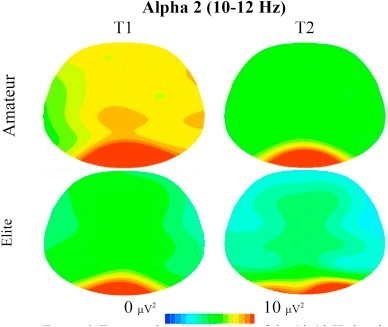ORIGINAL ARTICLE:本校公共事務中心 (2022-09-26)
[This article is provided by Professor Hung Tsung-Min’s Research Team, Department of Physical Education and Sport Sciences]
Understanding the cognitive-motor processes of elite athletes not only helps improve their performance but also enhances learning efficiency. This study used neuroscience tools to explore the dynamic psychomotor characteristics of elite golfers during performance. By comparing elite and amateur golfers during putting, the research aimed to uncover how elite athletes manage their cognitive and motor processes during high-level skill execution.
The study recruited 20 elite and 18 amateur golfers, each completing 60 putting trials while their brain activity was recorded using EEG. By comparing the EEG data from both groups, the results showed that, compared to amateurs, elite golfers displayed distinct brain activity patterns prior to putting, allocated more attentional resources to motor planning and visuospatial information processing, while simultaneously reducing interference in cognitive-motor processing. These findings not only highlight the importance of brain activity changes during athletic performance but also provide scientific evidence of the unique cognitive-motor processing patterns underlying elite athletic performance.
Understanding the cognitive-motor processes of elite skilled athletes not only provides relevant information to enhance motor performance, but also promote the efficiency of motor learning. However, psychomotor states during movement execution change dynamically over time, and few neuroscience studies examine elite athletes’ dynamic psychomotor features during performance via cognitive-motor processes.
This study is based on previous literature in sport neuroscience and compares the performance of elite and amateur golfers during putting, as well as the cognitive-motor processes during putting to explore the cognitive-motor processes of elite players during skilled performance.
The study recruited 20 elite golfers and 18 amateur golfers to perform 60 putting tasks while EEG data were simultaneously recorded. The EEG data of the two groups were compared (see Figure 1), and results revealed that elite players were characterized by:
(1) From 2 seconds to 1 second before putting, lower alpha-2 (10–12 Hz) power appeared in the parietal (Pz) and right temporal (T8) regions.
(2) From 1 second before to the initiation of putting, lower Mu-2 (10–12 Hz) power appeared in the frontal (Fz), right temporal, and central (Cz) areas.
(3) From 2 seconds before to the initiation of putting, lower alpha-2 coherence appeared between the frontal lobe and left temporal (T7), and between the frontal lobe and right temporal regions.
To summarize, these results show that elite golfers, before putting, allocate more attentional resources to motor planning and visuospatial attention processing, and reduce interference in cognitive-motor information processing. These findings not only highlight the importance of brain process changes during athletes’ movements, but also provide scientific evidence of the unique characteristics in cognitive-motor information processing underlying elite athletic performance.
(English Version Powered by ChatGPT, Edited by Serena H.)
Original Source:
Wang, K. P., Cheng, M. Y., Chen, T. T., Huang, C. J., Schack, T., & Hung, T. M. (2020).
Elite golfers are characterized by psychomotor refinement in cognitive-motor processes.
Psychology of Sport and Exercise, 50, 101739.
https://doi.org/10.1016/j.psychsport.2020.101739
This article comes from: Research Highlights, Office of Research and Development
Original Link: https://rh.acad.ntnu.edu.tw/tw/article/content/172
Dr. Kuo-Bin Wang, Postdoctoral Researcher, Department of Psychology and Sports Science, Bielefeld University, Germany
Dr. Wang’s research interests lie in applying neuroscience and psychological methods to explore ways to enhance motor learning and improve athletic performance. Recent research topics include the neural activity states between brain regions during putting among golfers of different levels, and the application of neurofeedback training methods to improve golf putting performance.
Dr. Cong-Min Hung, Distinguished Research Professor, Department of Physical Education and Sport Sciences
Professor Hung’s research interests include how to enhance cognitive ability through physical exercise, particularly in enhancing executive functions related to the prefrontal cortex. This is one of Professor Hung’s main research focuses. Another main research focus is applying neuroscience and psychology to enhance sports performance, and the findings in this article represent recent progress along that research direction.

圖一:菁英和業餘高爾夫選手在推桿前的大腦狀態差異。